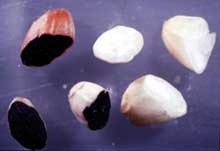NC State Geneticists Study Origin, Evolution of "Sticky" Rice

When tested in iodine, grains of non-glutinous rice turn black (left), while glutinous rice remains unstained. <br>
A study by two North Carolina State University geneticists traces the origin and evolution of a genetic mutation that long ago led to the creation of a type of rice known as glutinous, or “sticky,” rice.
The molecular genetic research leads researchers to believe that glutinous rice – which differs from non-glutinous, or common, rice on account of a mutation in its Waxy gene that suppresses the formation of a starch called amylose – most likely originated a single time in Southeast Asia. Further, DNA evidence – namely the lower-than-expected genetic variability in the Waxy gene – suggests that early domesticators of glutinous rice liked its adhesive quality and wanted to preserve that particular trait.
Dr. Michael Purugganan, associate professor of genetics, and Dr. Kenneth Olsen, post-doctoral research associate in genetics, publish their findings in the Oct. 23 edition of Genetics.
To learn more about the origin and evolution of sticky rice, the researchers studied 105 glutinous and non-glutinous samples of rice donated from the multitudinous stock kept by the International Rice Research Institute in Los Banos, Philippines.
Rice contains two starches: amylose and amylopectin. Glutinous rice lacks amylose; in fact, it is the lack of amylose that gives it its sticky composition. Non-glutinous rice – what you’d find if you cooked up a name-brand package of rice from the grocery store, for example – contains up to 30 percent amylose; the result is rice with grains that separate.
Glutinous rice is the staple food in some areas in Southeast Asia, including parts of Laos, Thailand and Cambodia, the researchers say. Sticky rice has also migrated north to become an important part of the diet in places like China and Japan. Used primarily in a number of desserts – rice cakes, for example – sticky rice has achieved important cultural standing in East and Southeast Asia.
But Asian folklore diverges on the origin of glutinous rice, Purugganan says. He found both a Laotian Buddhist legend charting the existence of glutinous rice to about 1,100 years ago and Chinese folklore that indicated the existence of glutinous rice more than 2,000 years ago.
“Since no one really knows where glutinous rice came from, we wanted to find its origin using molecular means,” Purugganan says. “We also wanted to find out the number of times the mutation in the Waxy gene that suppresses amylose, which produces glutinous rice, arose during rice domestication. And, we wanted to see if the Waxy gene showed evidence of selection by early Asian farmers.”
Performing genetic sequencing of these samples at NC State’s Genome Research Laboratory, Purugganan and Olsen assembled a “gene tree,” or network that represents patterns of genetic differences among the DNA sequences, Olsen explains.
Using the gene tree, the researchers found that sticky rice’s genetic mutation maps to a single mutation on the gene tree, suggesting that the mutation occurred a single time rather than more than once, Olsen says. Looking at the geographic locations of the rice DNA sequences that are direct ancestors of the mutation, the researchers found fairly strong evidence that Southeast Asia was the geographic origin of sticky rice. This squares with the fact that sticky rice is a staple in some parts of Southeast Asia.
“This type of research really opens up the window of not only how crops originate, but also how specific features evolve,” Purugganan says. Olsen adds, “This is one of the first times that anyone has looked within a crop species at the evolutionary and geographical origins of important domestication traits in crops.”
Purugganan and Olsen now plan to study other genes involved in starch synthesis in rice.
Research funding for the study of the origin and evolution of glutinous rice was provided
by the Alfred P. Sloan Foundation.
Media Contact
All latest news from the category: Life Sciences and Chemistry
Articles and reports from the Life Sciences and chemistry area deal with applied and basic research into modern biology, chemistry and human medicine.
Valuable information can be found on a range of life sciences fields including bacteriology, biochemistry, bionics, bioinformatics, biophysics, biotechnology, genetics, geobotany, human biology, marine biology, microbiology, molecular biology, cellular biology, zoology, bioinorganic chemistry, microchemistry and environmental chemistry.
Newest articles

Breaking the Ice: Glacier Melting Alters Arctic Fjord Ecosystems
The regions of the Arctic are particularly vulnerable to climate change. However, there is a lack of comprehensive scientific information about the environmental changes there. Researchers from the Helmholtz Center…

Global Genetic Insights into Depression Across Ethnicities
New genetic risk factors for depression have been identified across all major global populations for the first time, allowing scientists to predict risk of depression regardless of ethnicity. The world’s…

Back to Basics: Healthy Lifestyle Reduces Chronic Back Pain
Low back pain is a leading cause of disability worldwide with many treatments, such as medication, often failing to provide lasting relief. Researchers from the University of Sydney’s Centre for Rural…



